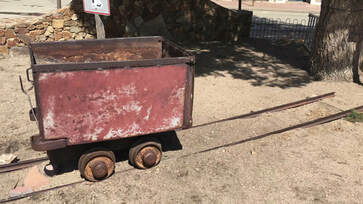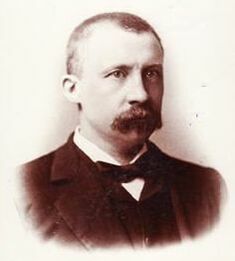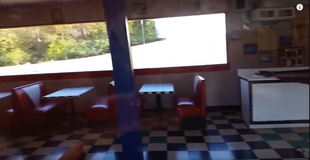 Georgetown Colorado Georgetown Colorado
Georgetown is a breathtaking community that sits 8,530 feet above sea level. It is nestled on the upper side of Clear Creek Valley, in Clear Creek County Colorado. The town is referred to as a “Territorial Charter Municipality”; however, it is considered a semi-abandoned town. This is because it once housed 10,000 residents and now holds just over 1,000 people. This town is far from dead and is fortunate not to be a complete ghost town or have succumbed to wildfire. In fact, it is one of the most well-preserved mining communities from the mid-1800s.
 Derelict Mining Cart Derelict Mining Cart
The town was started as a simple gold mining camp in 1859 during the Pike's Peak gold rush. Gold gave Georgetown its start however, it was silver that made the town the largest silver producer in Colorado (until 1878 when Leadville surpassed it). Although the town is small today, it was a historic cultural, and industrial center through the 19th Century. Earning itself the nickname the “Silver Queen of Colorado”.
 Alpine firehouse No.2 Alpine firehouse No.2
The town experienced less violence than its neighbors. Even though it had its share of undesirables and vagrants. Fortunately, it remained a mostly stable community. Allowing the economy and culture to flourish outside of the mine and its camps.
It was this fact that interested a young entrepreneur to heavily invest in the community, shaping it and the surrounding areas for centuries to come. In 1875 Louis Dupuy purchased and renovated an existing building into what we now call “The Hotel De Paris”. The hotel's opulence was unrivaled and unheard of in this region. The demand to stay at the hotel exceeded the rooms it had. Even during slow periods, Dupuy would personally approve each guest. Many were turned away for reasons only known to Dupuy. The hotel quickly became famous for its high-class atmosphere and sophisticated French dining.  Louis Dupuy Louis Dupuy
The success of The Hotel De Pari was desperately needed by Louis. He was an heir to a vast fortune and had squandered most of his inheritance. During this period he dabbled in many things but succeeded at little. He entered the seminary in hopes of joining the priesthood. When that didn’t work out he went to culinary school. He settled for a time as a writer in New York City, before being caught for plagiarism. Next, he did a stint with the United States Army, but he deserted for unknown reasons. At this time he changed his name from his given name, “Adolphe François Gerard”; to the name, we know today Louis Dupuy. Days later he walked into Denver's largest newspaper, the Rocky Mountain News and began to work as a mining reporter. This is what leads him to Georgetown where he eventually became a miner himself. In 1873 he was working at the nearby 7:30 mine when an explosion injured him severely. He was unable to perform hard labor and had a very long recovery time. During this time the community of Georgetown raised enough money for Louis to rent what was called the “Delmonico Bakery”. This humble building and the adjacent structure is what Dupuy later renovated into the world-renowned Hotel De Paris.
 Georgetown Colorado Georgetown Colorado
Ultimately Dupy was a French native who cultivated a new life and home for himself by recreating the style of Inns he knew as a child. He had a hard start to his life but was able to live out his days as the administrator of a hotel that we still talk about and visit to this day. His hotel and the adjacent opera hall shaped the region for generations to come.
Today Georgetown enjoys a lively summertime crowd of tourists. You’ll find most of the stores on the main street are open and see hourly rounds of tour buses from Denver. However; in winter the town becomes less busy as tourist and locals tend to visit ski areas. But this is a great time of the year to visit if you want to take it all in without too much of a crowd.  Kneisel Grocery Kneisel Grocery
One of the shops that rarely closes is the local grocery store, Kneisel Grocery. In fact, the store is still operated by members of the Kneisel Family. The structure houses three shop bays and was originally built by Henry Kneisel in 1892. The following year he moved his grocery business into one of the store stalls. He built the shelving in 1893 to his personal specifications and they are in use to this day. The Kneisel and Anderson Store is the oldest, continuously-operated business in Georgetown. Today, customers are served from behind the original counter.
 Georgetown Fire Hall No.1 Georgetown Fire Hall No.1
The single-bay building to the west was built somewhat later, and it also was initially a grocery store. Around 1912, Kneisel and Anderson purchased it and established their hardware business there, where it continues to this day.
I highly recommend you visit and spend some time in this town. The people are welcoming, the food is good, and the architecture is amazing. Photos from the Day:
0 Comments

The drive-in is about as American as it gets. We love our cars and going to the movies is the standard fallback plan every weekend. However, many of these beloved outdoor screens are in constant peril of closing, reopening, and closing again.

This summer, many theaters will be showcasing a live stream Jimmy Buffet concert, which in 2018 doesn’t seem to fit, but does the drive-in belong in the age of iPads and 3-D printing? The biggest event to happen to the drive-in industry, switching to digital, is advertised on dated websites with glittery backdrops that remind you of an early America Online profile. So why do we go? Why fight to keep these relics open? Because the drive-in’s quaint nature is no more than it advertises. In its simplicity, affordable tickets bring communities together on sticky summer nights and that’s a rarity today.

What we see in this video is the remains of an 1800’s silver town. I will be bringing you a few stories and videos from this area. However; I would like to take a moment to focus on this 1885 home and storefront and its tale.
This area is what is referred to as a Statutory Town or “Living Ghost Town”. Many tales abound from this town and region. One of the most well-known stories involves this building and a much-beloved citizen from the towns mining days; Clifford Griffin. According to the story, Griffin came from New York City, where he was raised. Mr. Griffin became engaged in New York, but his fiancé mysteriously, died the night before their wedding. The tragedy was attributed to “unnameable” or what we now call "natural causes". 
Like many do to this day, Griffin decided to escape the painful memories, by moving to Colorado. He moved with his brother, with the aim of forgetting his beloved. Eventually, he became the manager of the town's largest mine. He started his shifts at what was considered a very generous time, 7:30 AM. Later the mine was locally called and eventually renamed “The 7:30 Mine”.
lifford was very loved by his staff and was considered to be very kind. Each Christmas he bought all his miners a goose for their families. Every 4th of July, he paid off every bar tab between Silver Plume and what is current-day Bakerville. He did this so his miners and staff could enjoy their holiday without spending their family's money. In addition to taking care of his miners during the holidays, he provided them with nightly entertainment. 
Legend has it that he could not bear the daily sight of his men with their wives and families after his tragedy. Clifford spent a great deal of time near the entrance to the 7:30 mine, which sits 1,500 feet (460 m) over the town of Silver Plume. Every evening he would sit on the edge of a nearby cliff and play his violin. The valley has incredible natural acoustics, which carried the sound down for the entire town to hear. People stated that they “could step outside and listen to his evening concerts”.

According to local legend, after a particularly beautiful recital, the residents heard a single gunshot. Assuming the worst, the miners of the 7:30 raced up the trail to its entrance. Once there they found Clifford Griffin, shot through the heart and in a shallow grave he'd dug himself. In the Manager’s Office, a note was found. The note asked the residents of Silver Plume to leave him where he lay because that's where he'd experienced the most happiness since his wife died. The town honored his request and later erected a 10-foot-tall Gunnison-Granite monument in his honor. Which still sits to this day, directly on top of his grave site.
Photos from the day
Winfield is an old mining town tucked away in the San Isabel National Forest, outside Buena Vista. There are several original buildings, including a schoolhouse. It was founded on 120 acres at the junction of the north and south forks of Clear Creek. Lots of 50×100 were free to anyone who desired to build there. 
A cabin was built as early at 1861 with the first prospecting done in 1867. Winfield reached its heyday around 1890 when some 1500 folks lived in town.
There were 3 saloons, 3 stores, 2 hotels, a boarding house, a post office, a church, school, mill, smelter & concentrator. Mining came to an end in Clear Creek Canyon in the early 1900s. |
AuthorThank you for visiting! This is a collection of media from the lost and abandoned corners of the world. Please have a look around, I hope you enjoy. Archives
April 2022
Categories
All
|
Libraries |
Support |
|


